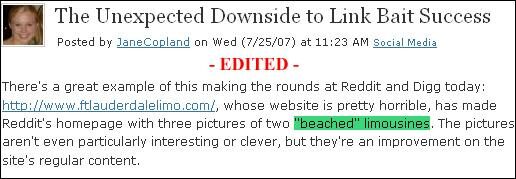I’ve been to two search marketing conferences in the past month and asked the crowd the same question at each show. The question was about a real-life example of the bait ‘n switch. There are a few different levels of bait ‘n switch and you’ll come across differing opinions as to which are ethical and which aren’t.
Level One
Popular content is moved via a redirect from its original location to another location on the same site. The content doesn’t change. This barely counts.
Level Two
Popular content is moved via a redirect from its original location to a different site. The content doesn’t change.
Level Three
Popular content is moved via a redirect from its original location to another location on the same site. The content is noticeably different.
Level Four
Popular content is moved via a redirect from its original location to a different site. The content is noticeably different.
By noticeably different, I mean that it no longer represents the content to which hundreds or thousands of independent websites originally linked. As linkers, we take this risk whenever we link to something that we don’t control; however, there is an inherent understanding that people won’t change the content and “force” us to link to something which we didn’t intend.
When the content doesn’t change, I don’t see anything wrong with changing its location. Within reason (commercial reasons included), moving content around makes little difference. Sometimes, a corporate website isn’t the place for linkbait or viral content, but once a social media campaign is complete, the content can be moved to a place on a company’s premier site. The Lenovo Tapes are a good example of this: originally displayed on a separate domain and purposefully disguised as being amateur, the page was eventually moved to Lenovo’s UK site. Sticklers for web etiquette still mightn’t like this, especially if they have a problem linking to corporate domains. However, I see no problem with this type of tactic and if you do, you should avoid linking to anything, ever.
Stickier situations come about when the content changes. If Lenovo had 301 redirected their linkbait to a products page, the situation would be entirely different. I fell for such a tactic recently and it was about this situation that I posed my question to two SMX crowds this April.
Last year, I was writing away at SEOmoz, as I’m prone to do, and I came across a benign but amusing piece of linkbait from a Floridian limousine company. They were featuring pictures of beached limos. Limos that have tried to drive over steep hills in towns like San Francisco and have become high-centred. Nice. Limousines are obscene. Who doesn’t find beached limos funny?
I linked to the linkbait. I used their most important keyword, “limousines”, in my anchor text. I was perfectly aware that the content was developed with links in mind, but being an SEO and having created similar commercially-minded content, I didn’t have a problem throwing them a followed link. Good on them; they topped Reddit and gave a few thousand people a giggle. Much later, I wanted to use this example in a presentation to highlight how boring businesses with mediocre websites can take advantage of social media. I went back to my own post to find the limousine company’s link.
I ended up at the Miami limousine rentals page, undoubtedly the company’s most profitable market.
Is that okay? Would I feel fine about doing this myself? Should I remove my link at SEOmoz? I felt that I should; however, I forgot to actually do it. I was distracted, probably by something shiny. The link was never removed and never nofollowed. I have the tab open to do it right now, but as per usual, I’m in the middle of a glass of Pinot and will probably forget again. Anyway.
I posed the question to the crowd at SMX Sydney: should I remove the link? Eighty percent of the crowd raised their hands. What an honest bunch of convicts. Either that, or they were just trying to impress us. I flew back to the U.S. and did nothing. A week later, at SMX Social Media in Long Beach, I asked the crowd the same question. Eight people put up their hands. The L.A. crowd didn’t see anything wrong with a 301 redirect being used in this way.
What do you think? I will probably amend the post to nofollow the link and add a note about how the content has changed. Personally, I wouldn’t use a redirect in this way: to me, a 301 should really indicate that a piece of content has moved permanently; doing this changes the content entirely. And it’s not like I’m the most morally upstanding member of society, either. Isn’t that right, Julie?
We had a discussion – one that ended up being around 250 comments in length – at SEOmoz last month about the ethics of widget-bait. Rightly or wrongly, a former colleague of mine is suffering from Google’s crackdown on such practices. How tough would it be for a search engine to recognise the bait ‘n switch and devalue its worth?
I have just decided that every SEO Chicks post I write will conclude with my most entertaining piece of Gmail Adsense from the recent past, as I was quite pleased with that particular post. Here is today’s offering: I always enjoy humour in my email advertising, especially of the self-deprecating variety.
Until next time!


